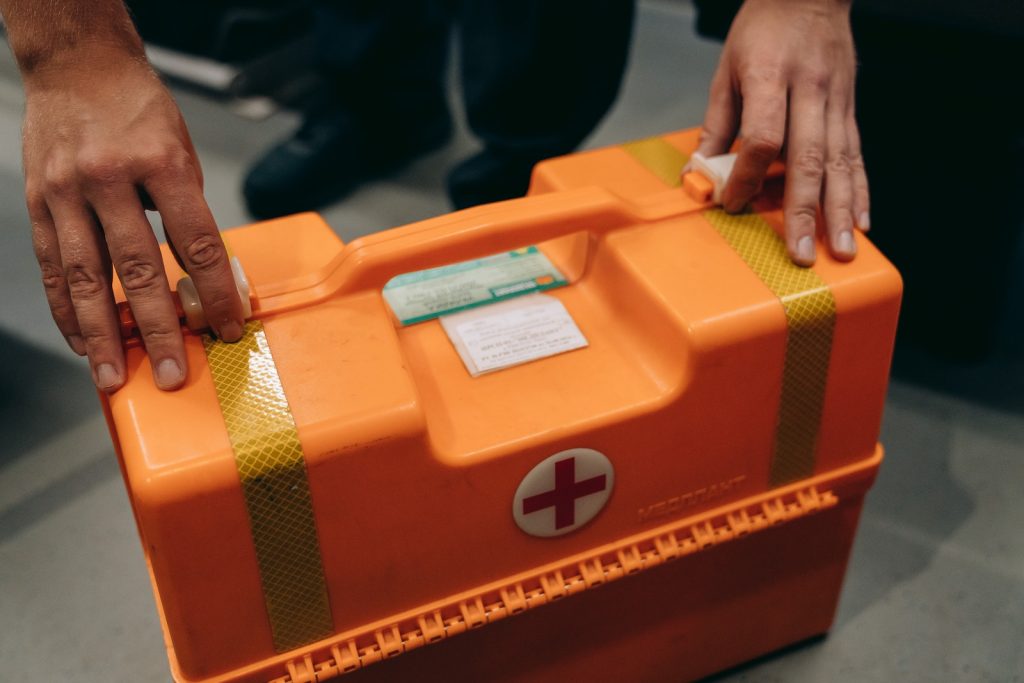Are you worried about what might happen if an unexpected emergency arises? Building a family emergency fund is the key to providing security and peace of mind for you and your loved ones.
In this article, we will guide you through the process of creating a solid financial safety net that can help you weather any storm.
Creating an emergency fund may seem like a daunting task, but with the right knowledge and strategies, it is completely achievable. By following our step-by-step guide, you will gain the practical knowledge needed to:
- Assess your current financial situation
- Set goals for your emergency fund
- Determine how much to save
- Create a budget
- Choose the right savings account
- Gradually build your fund over time.
With discipline and determination, you can protect your family from financial hardship in times of crisis.
So let’s get started on this journey towards building your family’s resilience!
Assessing Your Current Financial Situation
Take a look at your income, expenses, and savings to get a clear picture of where you currently stand financially. This is the first step in building a family emergency fund.
Assessing your current financial situation will help you understand how much money you have coming in, how much you’re spending, and how much you can potentially save. Start by examining your income sources. Calculate your monthly take-home pay after taxes and any deductions. Include all sources of income such as salaries, wages, bonuses, and side hustle earnings. Understanding your total monthly income will give you an idea of how much money you can allocate towards building your emergency fund.
Next, evaluate your expenses. Track all of your monthly expenses for at least one month to get an accurate understanding of where your money is going. Categorize these expenses into fixed costs (such as rent or mortgage payments) and variable costs (such as groceries or entertainment). Identifying areas where you may be able to cut back on unnecessary expenditures will allow you to free up more funds for saving.
Assess your current savings. Look at the balance in your savings account or any other investments that can be easily liquidated if needed. Determine how many months’ worth of living expenses this amount would cover in case of an emergency. If it falls short, consider increasing the amount you set aside each month or finding ways to boost your savings through budgeting adjustments.
By taking a thorough assessment of your current financial situation, including evaluating income sources, tracking expenses, and reviewing existing savings, you’ll gain valuable insights into where improvements can be made. Remember that building a family emergency fund is about being prepared for unexpected events while also creating a sense of security for yourself and those who depend on you.
Setting Financial Goals for Your Emergency Fund
Start by envisioning the future you want, where you feel secure and at ease knowing that you have a cushion to fall back on in times of unexpected challenges. Picture yourself confidently handling any financial emergencies that come your way, without feeling overwhelmed or stressed.
Setting financial goals for your emergency fund is crucial in making this vision a reality.
To begin, determine how much money you would like to have in your emergency fund. Consider factors such as your monthly expenses, the stability of your job, and any potential risks or uncertainties in your life. A general rule of thumb is to aim for at least three to six months’ worth of living expenses saved up. However, this amount can vary depending on your individual circumstances and comfort level.
Next, break down this larger goal into smaller milestones that are easier to achieve. For example, if you want to save $10,000 for your emergency fund and currently have nothing saved, start by setting a goal of saving $1,000 within the next three months. This approach allows you to track your progress more effectively and gives you a sense of accomplishment along the way.
Remember that building an emergency fund takes time and discipline. Be realistic with yourself about what you can afford to save each month while still meeting other financial obligations. Make it a priority by automating regular contributions from your paycheck or setting up automatic transfers from your checking account into a separate savings account dedicated solely to your emergency fund.
By setting clear financial goals for your emergency fund and taking consistent steps towards achieving them, you’ll be well on your way towards creating the security and peace of mind that comes with having a family emergency fund in place.
It is important to establish a specific target amount for your emergency fund, such as three to six months’ worth of living expenses. Additionally, you should regularly contribute to this savings account, whether it be through automatic transfers or allocating a portion of your income each month. By consistently adding to your emergency fund, you will gradually build up a substantial amount that can provide a safety net during unexpected situations, such as job loss, medical emergencies, or home repairs.
Remember, the key is to prioritize this fund and resist the temptation to use it for non-emergency expenses, ensuring that it remains intact and ready to be accessed when needed.
Determining the Ideal Amount to Save
Imagine yourself in a state of complete financial security, where you’ve accumulated a substantial safety net that shields you from unexpected challenges and provides peace of mind. One crucial step towards achieving this is determining the ideal amount to save for your family emergency fund.
Here are four key factors to consider when deciding on the right figure:
-
Monthly Expenses: Start by evaluating your monthly expenses. Include mortgage or rent payments, utilities, groceries, transportation costs, insurance premiums, and any other recurring bills. Calculate the total amount needed to cover these expenses for at least three to six months.
-
Job Stability: Assess the stability of your income source. If you have a steady job with little risk of unemployment or income fluctuations, saving three months’ worth of expenses might suffice. However, if your employment situation is uncertain or prone to volatility, aim for a more secure cushion of six months’ worth.
-
Health Insurance Coverage: Consider the extent of your health insurance coverage and deductibles when determining your emergency fund target amount. Medical emergencies can be financially draining even with insurance; having an additional buffer can help alleviate stress during such difficult times.
-
Unique Circumstances: Take into account any unique circumstances specific to your family’s needs. For example, if you have children or dependents with special medical conditions or require ongoing care, it may be wise to save more than the recommended minimum as an extra precautionary measure.
By carefully assessing these factors and setting realistic goals based on your personal circumstances, you can determine the ideal amount to save for your family emergency fund. Remember that building this financial safety net takes time and discipline but offers invaluable protection against unforeseen events while providing a sense of belonging within a community that prioritizes preparedness and safeguarding their loved ones’ well-being.
Creating a Budget and Cutting Expenses
Crafting a budget and finding ways to trim expenses can be an exciting journey towards financial stability and peace of mind. It allows you to take control of your finances and ensure that you have enough money to build a family emergency fund. Start by evaluating your current spending habits and identifying areas where you can cut back. This could be as simple as reducing your dining out expenses or canceling unused subscriptions. Remember, every dollar saved is a step closer to achieving your financial goals.
To help you get started on this journey, here’s a table that showcases common expenses and potential cost-cutting strategies:
| Expense | Cost-Cutting Strategies | Potential Savings |
|---|---|---|
| Dining Out | Cook meals at home | $100 per month |
| Cable/Streaming | Switch to a cheaper plan | $50 per month |
| Gym Membership | Exercise outdoors or at home | $30 per month |
| Shopping | Buy second-hand or on sale | $50 per month |
| Utilities | Reduce energy consumption | $20 per month |
By implementing these strategies, you could potentially save around $250 per month! Imagine the sense of accomplishment knowing that you have taken concrete steps toward building your family emergency fund. Not only will it provide financial security, but it will also give you peace of mind when unexpected expenses arise.
Remember that cutting back on expenses doesn’t mean depriving yourself completely. It’s about making conscious choices that align with your priorities and long-term goals. As you embark on this budgeting journey, remind yourself that each small saving adds up over time. Stay committed, stay disciplined, and soon enough, you’ll see the positive impact it has on both your bank account and overall well-being
Choosing the Right Savings Account
To make sure you’re putting your money in the right place, it’s crucial to choose a savings account that fits your financial needs like a glove.
When it comes to building a family emergency fund, selecting the right savings account can make all the difference. Start by considering your goals and priorities. Are you looking for high interest rates or easy access to your funds? Do you prefer an online bank or a traditional brick-and-mortar institution? By understanding what matters most to you, you can narrow down your options and find the perfect savings account that aligns with your needs.
Next, take a close look at the fees associated with each savings account. Some accounts may charge monthly maintenance fees or require minimum balances, which can eat into your hard-earned savings over time. Look for accounts that offer fee waivers or low-cost alternatives. Additionally, consider any perks or benefits that come with certain accounts. Some banks may offer rewards programs or additional services like free financial planning consultations. These extra features can provide added value and help you maximize the potential of your emergency fund.
Lastly, don’t forget to compare interest rates across different savings accounts. While it may not seem like much initially, even a slightly higher interest rate can significantly impact the growth of your emergency fund over time. Look for accounts that offer competitive rates and consider whether fixed or variable rates are more suitable for your needs. Remember, building an emergency fund is about long-term financial security, so finding an account that offers attractive interest rates can be key in growing and preserving your funds.
Choosing the right savings account is an essential step in building a family emergency fund. By understanding your priorities, assessing fees and benefits, as well as comparing interest rates, you’ll be able to find an account that suits both your short-term and long-term financial goals.
Take the time to research different options and ask questions if needed; after all, this is about securing stability for yourself and those you care about. With the right savings account in place, you can rest assured that you’re on the right path towards a strong and resilient financial future.
Automating Your Savings
Start automating your savings today and watch how quickly your money grows – studies have shown that people who automate their savings are able to save 32% more than those who don’t.
Automating your savings is a simple yet highly effective way to build your family emergency fund. By setting up automatic transfers from your checking account to a separate savings account, you can ensure that a portion of your income goes directly into savings without any extra effort on your part.
Automating your savings not only helps you save more money, but it also makes the process easier and less stressful. You won’t have to remember to manually transfer money each month or worry about forgetting to save during busy times. Once you set up the automation, it becomes a habit that requires little conscious effort. This allows you to focus on other aspects of building financial security for your family.
Furthermore, automating your savings provides a sense of security and belonging within your family unit. Knowing that you have an emergency fund in place gives you peace of mind and reassurance during uncertain times. It shows that you’re taking proactive steps to protect yourself and your loved ones financially. Additionally, by involving the entire family in the process, such as discussing financial goals together or celebrating milestones reached through automated saving, you foster a sense of unity and shared responsibility towards building a strong financial foundation for the future.
So why wait? Start automating your savings today and join the millions of individuals who’ve successfully grown their emergency funds through this simple strategy. By making saving effortless and integrating it into your daily life, you’ll be well on your way to achieving financial stability for yourself and providing security for those who matter most – your family.
Building the Emergency Fund Gradually
By gradually setting aside money each month, you’ll experience a sense of accomplishment as your financial safety net grows. Building an emergency fund doesn’t have to be overwhelming or stressful. Instead, break it down into manageable steps and watch your savings grow steadily over time.
Here’s how:
-
Start small: Begin by setting aside a small amount of money each month, even if it’s just $50 or $100. It may not seem like much at first, but every little bit adds up over time. By starting with a manageable amount, you’ll be more likely to stick with the habit of saving.
-
Increase gradually: As your financial situation allows, try to increase the amount you save each month. Aim for incremental increases that won’t strain your budget too much. For example, if you were saving $50 initially, try increasing it to $75 or $100 after a few months. This gradual approach will ensure that building your emergency fund remains sustainable in the long run.
-
Automate the process: Take advantage of technology and automate your savings whenever possible. Set up automatic transfers from your checking account to a separate savings account designated for emergencies only. This way, you won’t even have to think about saving – it will happen automatically without any effort on your part.
-
Celebrate milestones: Don’t forget to celebrate when you reach certain milestones along the way! Whether it’s reaching a specific dollar amount or saving consistently for six months straight, acknowledge and reward yourself for these achievements. This positive reinforcement will keep you motivated and reinforce the importance of building an emergency fund.
Remember that building an emergency fund is not just about financial security; it’s also about peace of mind and knowing that you’re prepared for unexpected expenses or emergencies that may arise in the future. By following these simple steps and gradually increasing your savings each month, you’ll be well on your way to creating a strong financial safety net for you and your family.
Avoiding Temptation and Maintaining Discipline
Maintaining discipline and resisting temptation can be challenging, but it’s crucial for long-term financial stability.
When building a family emergency fund, it’s important to stay committed to your goal and avoid impulsive spending. It may be tempting to splurge on unnecessary items or indulge in expensive outings, but remember that every dollar saved brings you closer to achieving financial security.
To avoid temptation, start by creating a budget that clearly outlines your income and expenses. This will help you understand where your money is going and identify areas where you can cut back. Be mindful of small daily expenses that can quickly add up over time. Consider packing lunches instead of eating out or finding free or low-cost entertainment options for your family.
Another effective strategy is to automate your savings. Set up an automatic transfer from your paycheck into a separate savings account dedicated solely to your emergency fund. By making saving a priority and treating it as if it were any other bill, you eliminate the temptation to spend that money elsewhere.
Remember, maintaining discipline requires commitment and sacrifice in the short term, but the rewards are worth it in the long run. Building a family emergency fund provides peace of mind knowing that you have a safety net in case unexpected expenses arise.
So stay focused on your goal, resist impulse purchases, and embrace the sense of belonging that comes with taking control of your financial future alongside like-minded individuals who prioritize their family’s well-being as much as you do.
Reevaluating and Adjusting Your Emergency Fund
Reevaluating and adjusting your emergency fund is like navigating through changing tides – it requires adaptability to ensure your financial security stays afloat.
Life is unpredictable, and what may have been enough savings a few years ago might not be sufficient now. It’s crucial to regularly review your family’s needs and circumstances to make sure your emergency fund can handle any unexpected expenses that may come your way.
Start by reevaluating your monthly budget and identifying areas where you can cut back on expenses. By reducing unnecessary spending, you can free up more money to contribute towards your emergency fund. It’s also essential to take into account any changes in income or financial goals that may impact the amount you need to save. For example, if you’ve recently had a pay increase or are planning for a major life event such as buying a house or having children, you may need to adjust the size of your rainy day savings accordingly.
Another aspect of reevaluating and adjusting your emergency fund is considering inflation and the rising cost of living. Prices for goods and services tend to increase over time, so it’s crucial to factor this into your savings goals. Regularly reassessing the adequacy of your emergency fund ensures that it keeps pace with inflation and maintains its purchasing power. This way, you can have peace of mind knowing that even if prices rise, you’ll still be able to cover unforeseen expenses without dipping into other savings or going into debt.
Reevaluating and adjusting your emergency fund is an ongoing process that requires flexibility and foresight. By regularly reviewing your financial situation, making necessary adjustments based on changes in income or expenses, and accounting for inflationary pressures, you can ensure that your family remains financially secure during challenging times. Remember: building an emergency fund is not a one-time task but rather a continuous journey towards long-term stability.
Utilizing the Fund Wisely during Emergencies
During difficult times, you can make the most of your safety net by strategically tapping into it to navigate through financial storms. Your family emergency fund is there to provide a sense of security and stability when unexpected expenses arise.
Here are some ways you can utilize your fund wisely during emergencies:
-
Prioritize essential needs: When facing an emergency, it’s crucial to prioritize your essential needs. Use your emergency fund to cover immediate expenses like rent/mortgage payments, utilities, groceries, and medical bills. By focusing on these necessities first, you can ensure that your family’s basic needs are met during challenging times.
-
Minimize non-essential spending: In order to stretch your emergency fund further, it’s important to minimize non-essential spending. Cut back on discretionary expenses such as eating out, entertainment subscriptions, or unnecessary purchases. This will help preserve funds for critical situations and allow you to make the most of what you have in times of need.
-
Explore alternative income streams: During emergencies, it may be necessary to explore alternative sources of income. Consider part-time work opportunities or freelance gigs that can provide additional cash flow while preserving your emergency fund for truly unforeseen circumstances. By being proactive in seeking out additional income streams, you can maintain financial stability and protect your family’s future.
By following these strategies and utilizing your family emergency fund wisely during emergencies, you can weather financial storms with confidence and peace of mind. Remember that the purpose of this fund is to provide a safety net for unexpected events that may come along life’s journey.
Stay focused on essential needs, minimize non-essential spending, and be open-minded about alternative income options – all while knowing that you have built a strong foundation for yourself and your loved ones in times of uncertainty.
Frequently Asked Questions
Can I use my emergency fund to pay off debts?
Yes, you can definitely use your emergency fund to pay off debts. In fact, it may even be a wise decision that brings about the perfect alignment of financial freedom and peace of mind.
Picture this: you’ve diligently saved up for unexpected circumstances, and suddenly find yourself facing looming debts that are causing stress and worry. By tapping into your emergency fund, you not only alleviate the burden of those debts but also create a sense of security and control over your finances.
It’s like finding that missing puzzle piece that completes the picture of financial stability in your life. So go ahead, use your emergency fund to tackle those debts head-on and experience the joy of taking charge of your financial well-being.
How often should I reassess and adjust my emergency fund?
To ensure that your emergency fund remains adequate and relevant, it’s important to reassess and adjust it periodically. Life is unpredictable, and circumstances can change rapidly, so it’s recommended to review your emergency fund at least once a year.
However, certain significant life events such as having a baby, buying a house, or changing jobs may require more frequent evaluations. Take the time to consider any changes in your financial situation or expenses that would impact the amount of money you would need in case of an emergency.
By regularly assessing and adjusting your emergency fund, you can have peace of mind knowing that you’re prepared for unexpected situations that may arise without jeopardizing your financial stability.
What types of expenses should I include in my emergency fund budget?
When it comes to creating a budget for your family emergency fund, it’s important to consider all potential expenses that could arise in times of crisis.
While some may argue that including certain expenses is unnecessary and will only increase the amount you need to save, think about this: emergencies often come unexpectedly and can be incredibly stressful.
By planning ahead and including a wide range of possible expenses like medical bills, car repairs, home repairs, job loss, or even unexpected travel costs, you are ensuring that you have the financial security to handle any situation that may arise.
It’s better to be over-prepared than under-prepared when it comes to protecting your family’s well-being.
Is it advisable to invest my emergency fund in stocks?
It’s not advisable to invest your emergency fund in stocks. The purpose of an emergency fund is to have readily accessible funds in case of unexpected expenses or financial emergencies. Investing in stocks involves a certain level of risk and volatility, which could result in losses or limited access to your funds when you need them the most.
Instead, it’s recommended to keep your emergency fund in liquid and low-risk accounts such as a high-yield savings account or a money market account. This way, you can ensure that your funds are easily accessible whenever you may need them for any unforeseen circumstances that may arise.
Can I use my emergency fund for non-emergency expenses, such as a vacation or home renovation?
Absolutely not! Your emergency fund is specifically meant for unexpected emergencies and should not be used for non-emergency expenses like vacations or home renovations. It’s crucial to have a separate fund designated for those types of expenses so that you can maintain financial stability in case of an emergency.
Using your emergency fund for non-essential expenses would defeat the purpose of having it in the first place and could leave you vulnerable if a true emergency arises. So, it’s essential to prioritize building a family emergency fund separately and resist the temptation to dip into it for anything other than genuine emergencies.
Conclusion
Congratulations! You’ve successfully completed the journey of building a family emergency fund. Now, you can sleep peacefully at night knowing that you’re financially prepared for any unexpected events that may come your way.
But wait, there’s more! Not only are you now a master of financial planning, but you’ve also unlocked the secret to a stress-free life. No longer will you be haunted by the fear of sudden expenses or unforeseen circumstances. Instead, you can confidently face whatever life throws at you with a smirk on your face and money in your pocket.
Remember, building an emergency fund isn’t just about saving money; it’s about taking control of your future and securing peace of mind for yourself and your loved ones. So go ahead and celebrate this achievement! Treat yourself to something nice (within reason, of course) because you deserve it.
But don’t stop here. Keep growing and nurturing your emergency fund as time goes on. Just like a plant needs water and sunlight to flourish, your emergency fund needs regular contributions and attention to thrive. So continue assessing your financial situation, setting goals, and adjusting as needed.
In conclusion, my dear reader, the path to financial security isn’t always easy or glamorous. It requires discipline, sacrifice, and determination. But trust me when I say that it’s worth every penny saved. So go forth into the world with confidence and remember: emergencies may come knocking on your door uninvited, but now you’re armed with the ultimate weapon – a well-funded emergency fund!







